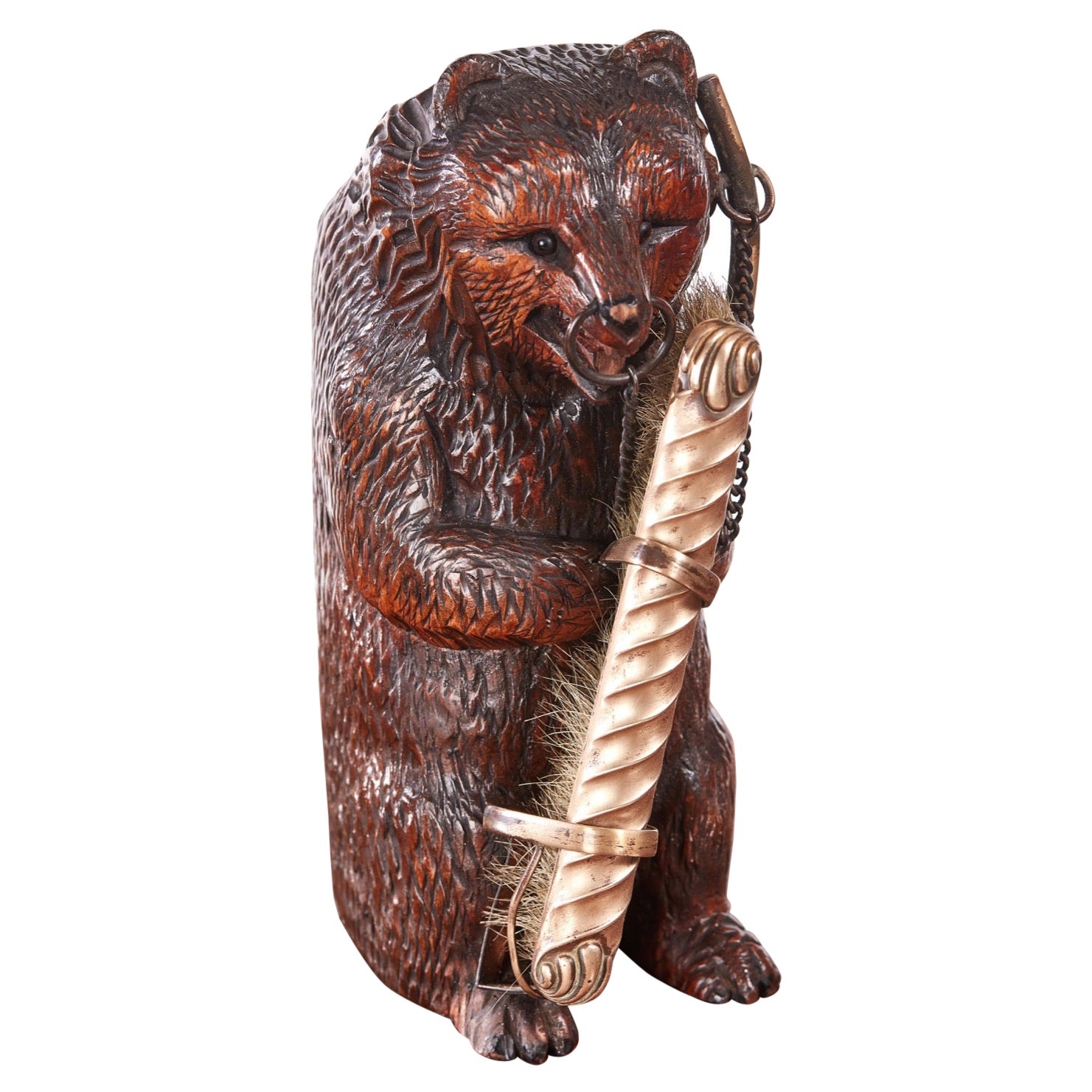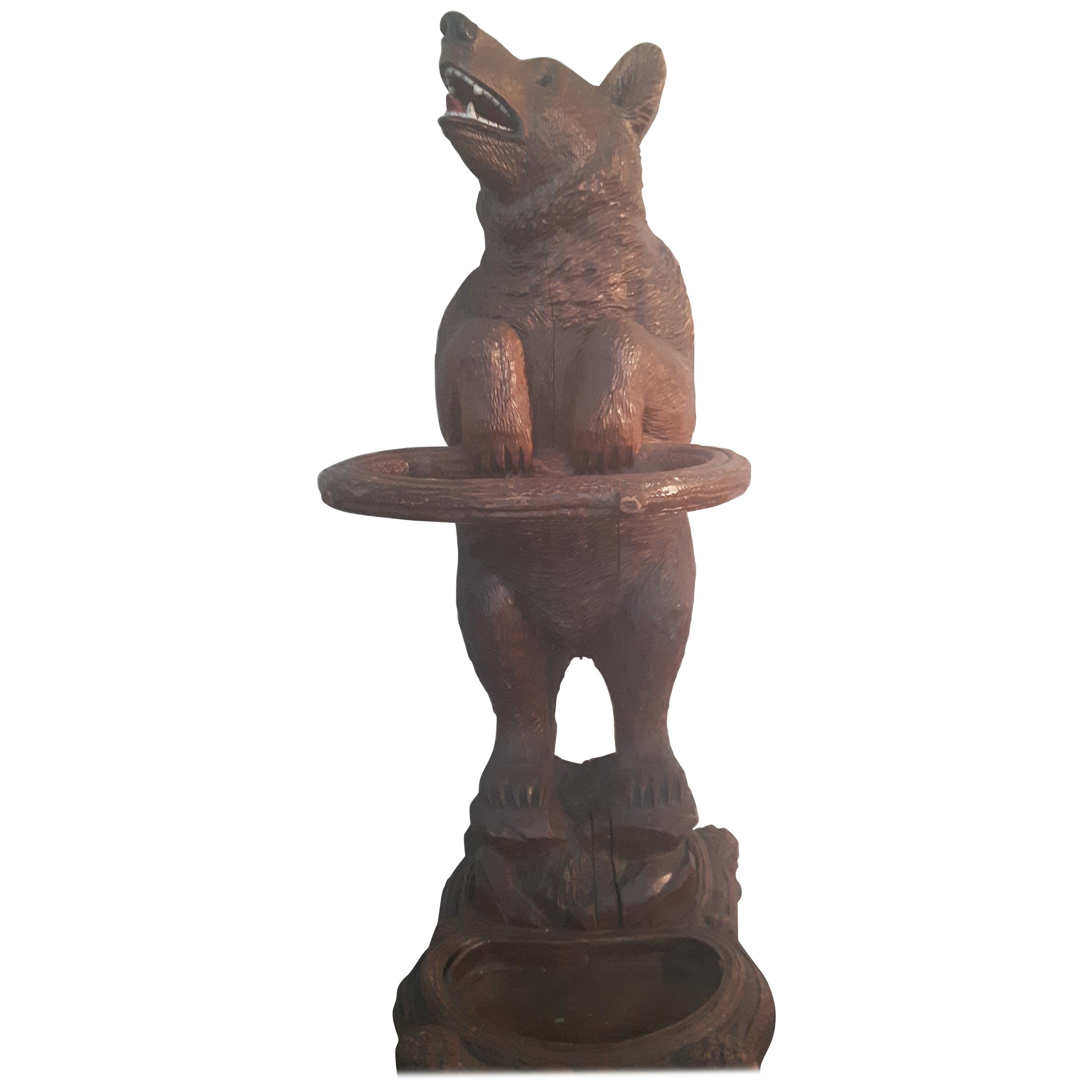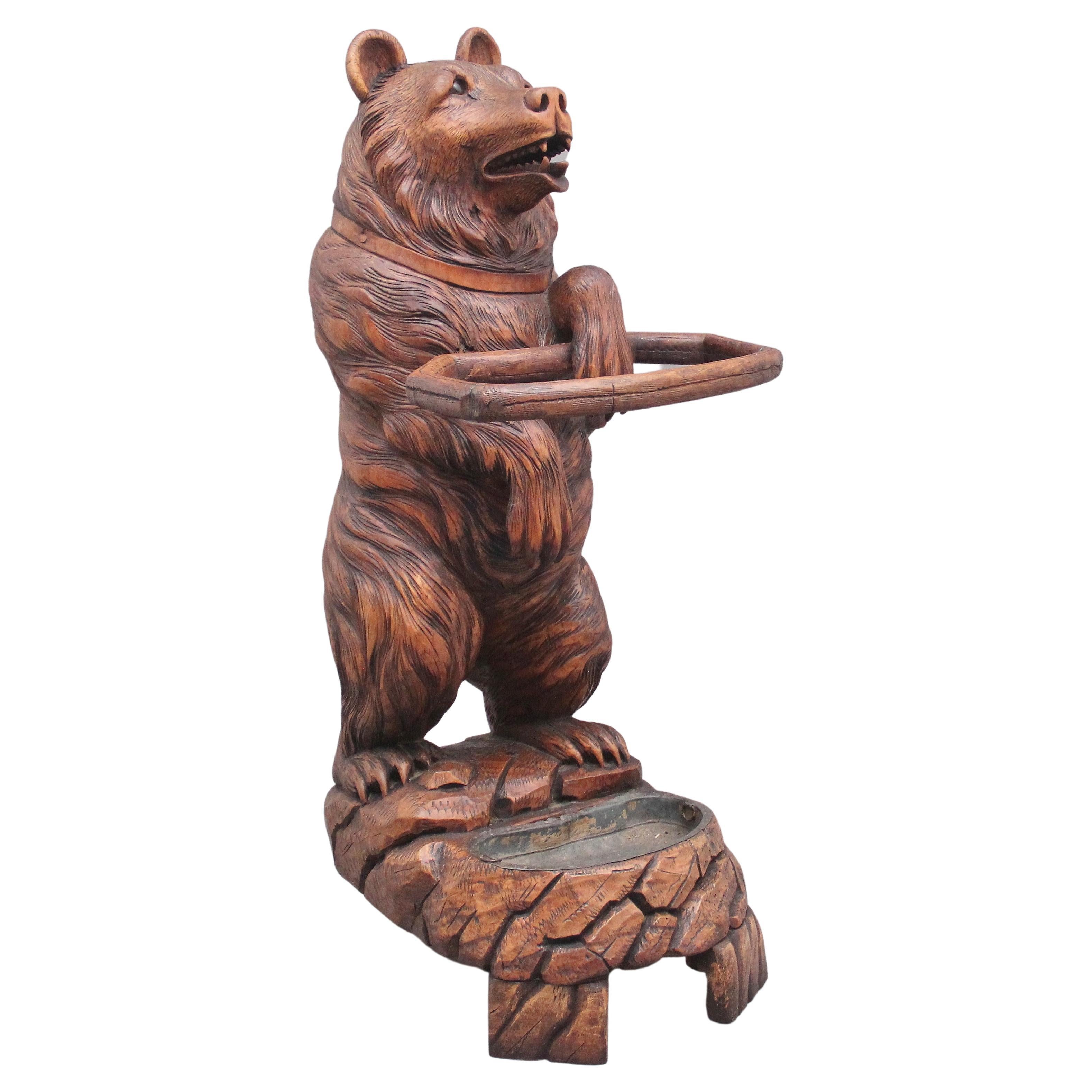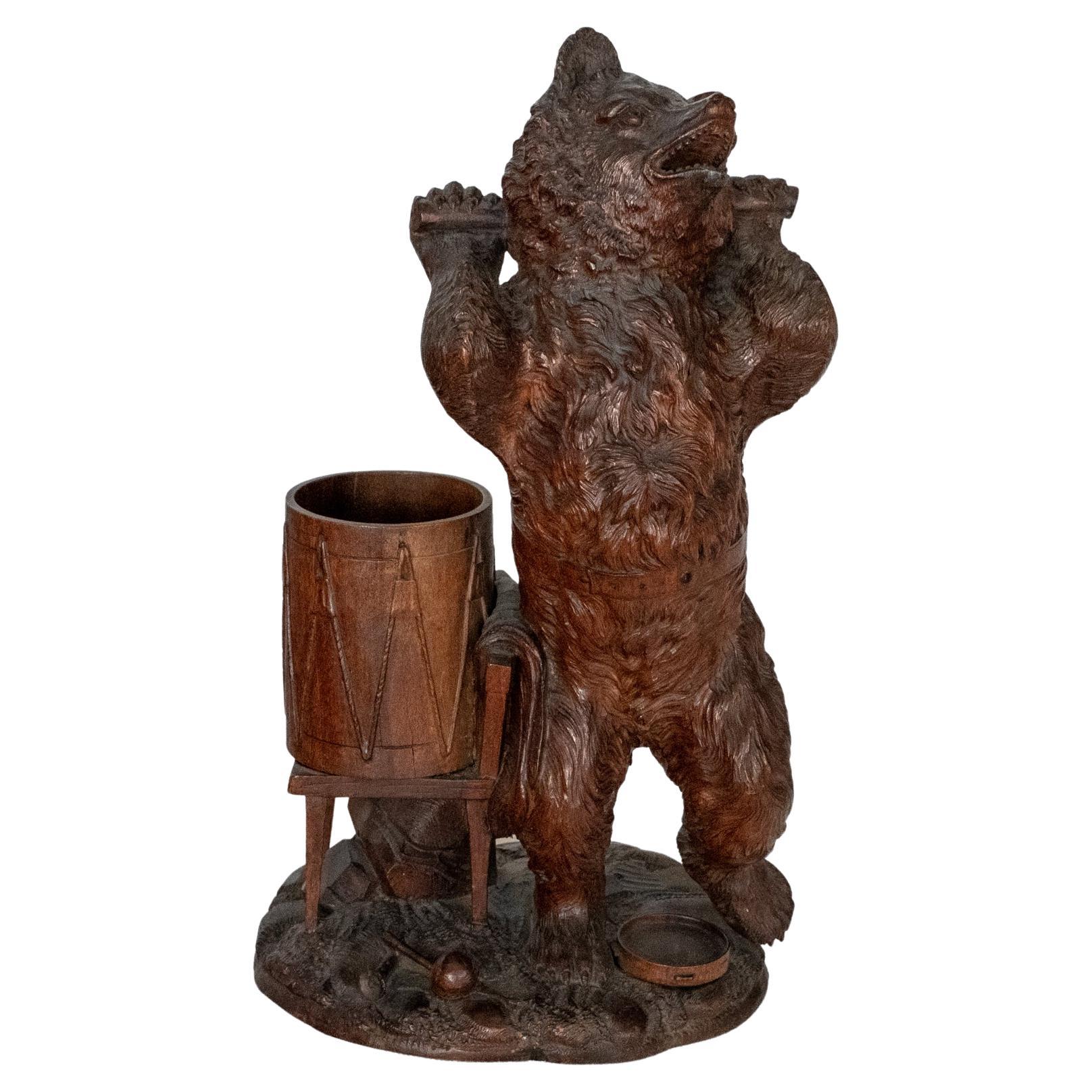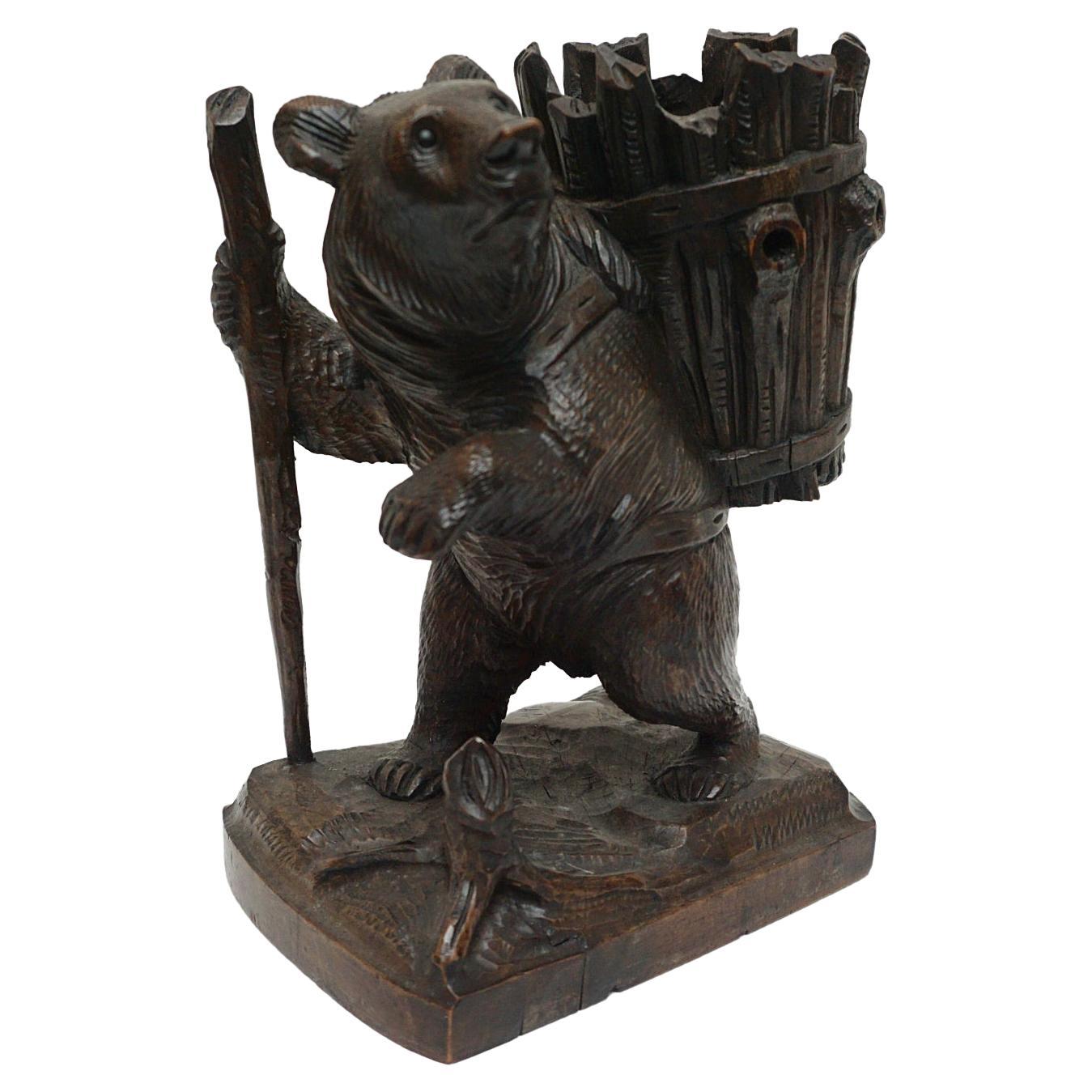Items Similar to Antique Hand Carved Black Forest Bears Inkstand 19th Century
Want more images or videos?
Request additional images or videos from the seller
1 of 11
Antique Hand Carved Black Forest Bears Inkstand 19th Century
About the Item
This charming antique Black Forest inkstand dates from circa 1880.
Beautifully modelled, hand carved from linden wood, with mother and baby bear on a naturalistically carved rocky outcrop.
The inkwells are in the form of a pair of tree trunks with fluted glass wells with carved lids and a useful pen tray in front.
Condition:
In excellent condition. As an antique item, it shows signs of use commensurate with age, these minor condition issues are mentioned for accuracy and, as seen in the accompanying photographs, the inkstand displays beautifully.
Dimensions in cm:
Height 15 cm x Width 23 cm x Depth 14 cm
Dimensions in inches:
Height 6 inches x Width 9 inches x Depth 5 inches
History of Black Forest Carving
The idea behind the success of Brienz wood carving was quite simple. After a disastrous famine in 1816 in the Brienz area people were forced to find new areas of revenues. Driven by the need to create jobs in the Bernese Oberland, an economically underdeveloped region, the Swiss government encouraged the existing resource of timber industry to liaise with the traditional wooden craftsmanship. It took some time to improve from home requirements to sophisticated designed arts but the process was supported by the rising amount of tourists visiting the region.
Christian Fischer and other founders
Christian Fischer (1790-1848) started self-taught from simple turneries (carved bowls and other articles of daily use) to unsophisticated regional animals and people. Due to his success and the interest of the tourists, other carvers started also following his idea of carving the pristine naturalism. The Swiss government supported these start-ups with additional training of apprentices at special trade school.
Brienz School of Wood Carving
In 1884 the "School of Wood Carving, Brienz" was founded. It became an important educational institution to strengthen and develop the artistic backgrounds and exhibit an area of creativity. During the years of war in the 20th century, the demand for wooden sculptures came to rest and led to the re-orientation in areas such as toys and carvings for constructions. Beyond that the Brienz wood carving articles had to face an enormous competition from abroad. The School of Wood Carving had to get through difficult economic times but in the late 1970s wood carving enjoyed a renaissance. A lot of young people searched for elemental jobs and added a new value to school education. Today Brienz School of Wood Carving is combined with the education of turner, basket makers and coopers. The school still claims high-quality standards and follows old principles with regard to future perspectives.
Wild animals
At all times wild animals fascinate people. The highland around Brienz has large variety of different wild animals. Bears are among the most popular models for carvers. On the one hand bears are easy to cut and on the other hand they have a strong symbolized image. The enthusiasm for bears in art increased in the meantime the population endangered. One can say that hardly any other wild animal evolved from dangerous to fetish or even cute. Like the company Steiff with its Teddy bear collection, the Brienz´carvers reached inimitability.
Beyond that Brienz carvers used eagles, ibexes, chamois, deer, boars and owls frequently as models with an individual character. The Brienz School of Woodcarving even kept an own zoo with these animals to offer their students the opportunity to observe these animals on a regular basis.
Another remarkable capability of Brienz woodcarvers was their adaptability towards their customers. During the First World War several US soldiers were on R & R in the political and military neutral country of Switzerland. The American soldiers were enthusiastic about the beautiful animal sculptures and Brienz artificers started to carve local North American animals with an enormous success.
Alps´animals
Tourists were not only crazy about wild animals but they were also inspired by the typical domestic animals living in Swiss villages. Cows with their characteristic bells represent a mystery to rural life. A farm animal dedicated for production but still noticed as wild and unbroken, is an ideal illustration for artists to haunt. Goats, the headstrong all-rounder and the oldest domesticated animal, can be illustrated with great fidelity in sculptures. The St. Bernhard dog is a perfect representative of men´s.
People living in the Alps had a strong relationship to their regional living animals and it suggested itself that artists started to disguise e.g. bears. Camouflage has always been a fired artist´s imagination and license. Brienz wood carvers began to create whimsical sculptures or combinations for daily use such as a mandolin playing bear whip holder with music work integrated in the body which starts playing when something is hanged on the chamois horns.
The simple life in the Alps appealed the foreigners and encouraged artists to focus on human figures, especially hunters, poachers and shepherds. Another inspiring category were ornamental carvings of articles of daily use, such as clocks or thermometers. Since 1850 Brienz carvers started to focus on creating sculptures showing men, animals and floral motives with an outstanding and independent artist standard.
Despite of wooden sculptures Brienz carvers also created a broad range of individual furniture. The main influence to diversify in this competitive market was given by teachers from the Brienz School of Woodcarving in the late 1850s. Apart from company Gebrüder Wirth the success in standard furnishing was quite neglectable. But the Brienz carvers meet the challenge and started to develop a niche market with a significant furniture style related to Renaissance, Rococo and or Art Nouveau. They played on their strengths and combined animal carvings with furniture. The mixture of furnishings of daily use like umbrella stands with bear, dog or goose sculptures together with the bear seatings and gnome tables which were more appearance than function showed the versatility of Brienz artists. Brienz artificers created grandiose Elephant Furniture for wealthy British Indian colonists vacationing in the picturesque region around Brienz. Another high point in Brienz singularity furnishings were the so-called hall trees: a decorative perfection meeting an ingenious assembly. The majestic size of such a tree combined with the proficiency of carving and finally the whimsically look showed the uniqueness of Brienz creations.
Our reference: 09050
- Dimensions:Height: 5.91 in (15 cm)Width: 9.06 in (23 cm)Depth: 5.52 in (14 cm)
- Materials and Techniques:
- Period:
- Date of Manufacture:circa 1880
- Condition:
- Seller Location:London, GB
- Reference Number:
About the Seller
5.0
Platinum Seller
These expertly vetted sellers are 1stDibs' most experienced sellers and are rated highest by our customers.
Established in 1983
1stDibs seller since 2012
1,212 sales on 1stDibs
Typical response time: 1 hour
Associations
LAPADA - The Association of Arts & Antiques Dealers
- ShippingRetrieving quote...Ships From: London, United Kingdom
- Return PolicyA return for this item may be initiated within 14 days of delivery.
More From This SellerView All
- Antique Hand Carved Black Forest Deer's Head Hat & Coat Rack 19th CenturyLocated in London, GBThis is a stunning and rare Black Forest wall mounted carved deer's head hat and coat rack with glass eyes and with branch and leaf decoration,...Category
Antique 1880s English Models and Miniatures
MaterialsWood
- Antique Silver Plated Hand Bell Renaissance Revival 19th CenturyBy Elkington & Co.Located in London, GBAntique Silver Plated Renaissance Revival Hand Bell by the renowned silversmith and retailer, Elkington & Co, late 19th Century in date. The heavy cast bell surmounted with a cherub figure, the bell further worked with dancing cherubs. This bell is in truly excellent condition and is sure to make an outstanding contribution to your collection. Condition: In excellent condition, please see photos for confirmation. Dimensions in cm: Height 17 cm x Width 8.5 cm x Depth 8.5 cm Dimensions in inches: Height 7 inches x Width 3 inches x Depth 3 inches Elkington & Co was a silver manufacturer from Birmingham, England. The firm was founded by George Richards Elkington and his brother, Henry Elkington, in the 1830s. It operated under the name G. R. Elkington & Co. until 1842, when a third partner, Josiah Mason, joined the firm. It operated as Elkington, Mason, & Co. until 1861, when the partnership with Mason was terminated. The firm operated independently as Elkington & Co. from 1861 until 1963. It was then taken over by British Silverware...Category
Antique 19th Century Abstract Sculptures
MaterialsSilver Plate
- Antique Large Alabaster Sculpture P. Emilio Fiaschi 19th CenturyBy Emilio FiaschiLocated in London, GBThis is a splendid antique Italian carved alabaster sculpture of a figural group titled 'The Artist's Muse' by P. Emilio Fiaschi (Italian, 1858-1941), circa 1890 in date. This finely carved sculpture depicts a beautiful young couple modelled as a young artist in Renaissance dress holding a palette and leaning over a maiden seated in a Savonarola chair with paw...Category
Antique 1890s Italian Figurative Sculptures
MaterialsAlabaster
- Antique Library Bronze of Napoleon Bonaparte 19th CenturyLocated in London, GBThis is a finely cast brown patinated bronze Grand Tour sculpture of Napoleon Bonaparte, Mid 19th Century in date. It features Napoleon standing contrapposto in uniform wearing a...Category
Antique 1850s Figurative Sculptures
MaterialsBronze
- Antique Rare French Iron & Bronze Duck Press 19th CenturyLocated in London, GBThis is a fine substantial antique French iron and bronze Duck Press, stamped in relief "Depose" and dating from the late 19th Century. The main frame of the duck press is decorate...Category
Antique Late 19th Century French Figurative Sculptures
MaterialsSilver Plate, Bronze
- Antique Victorian Bronze Sculpture of Greek God Apollo 19th CenturyLocated in London, GBThis is a truly magnificent antique Victorian patinated bronze sculpture of the famous Greek God Apollo, modelled upon a shaped circular socle, inscribed monogram 'NF' and numbered 2...Category
Antique 1860s English Victorian Figurative Sculptures
MaterialsBronze
You May Also Like
- Unusual 19th Century Antique Carved Black Forest BearLocated in Suffolk, GBUnusual 19th century antique carved Black Forest Bear with a brass brush and original glass eyes. It has a lovely original colour. Measures: Height : 24 cm Width : 9 cm Dept...Category
Antique 19th Century English Animal Sculptures
MaterialsHardwood
- 19th Century Black Forest BearBy Black ForestLocated in London, GBA large Black Forest bear in the form of stick stand on a rocky base with roaring expression, stained red tongue.Category
Antique Late 19th Century Swiss Black Forest Animal Sculptures
MaterialsWalnut
- 19th Century 'Black Forest' BearLocated in London, GBA 'Black Forest' Bear In naturalistically carved lindenwood, having glass eyes, head tilted aloft, prowls on all fours. From the Brienz Area. Brienz, in the Bernese Oberland, Sw...Category
Antique Late 19th Century Swiss Black Forest Animal Sculptures
MaterialsWood
- 19th Century Antique Black Forest Bear Stick StandLocated in Martlesham, GB19th century black forest bear stick/umbrella stand constructed in linden wood, the stand consisting of a bear standing on his back legs with a front paw extended, with a naturalisti...Category
Antique 1880s Swiss Animal Sculptures
MaterialsHardwood
- 19th century Carved Walnut Black Forest Bear / Cigar HolderLocated in San Francisco, CALate 19th century Continental carved walnut bear / cigar holder. In the style of Black Forest, German, Possibly Russian. The complex form of a classic dancing bear on hind legs. Stan...Category
Antique Late 19th Century German Black Forest Animal Sculptures
MaterialsWalnut
- Late 19th Century Black Forest Carved Bear circa 1900Located in Forest Row, East SussexA Black Forest carved walking bear. Fine hand carved detail with original glass eyes. Linden wood. Dimensions: H 22cm W 15cm D 11.5cm Origin: Swiss Date: Circa 1890 Item...Category
Antique Late 19th Century Swiss Black Forest Animal Sculptures
MaterialsWood
